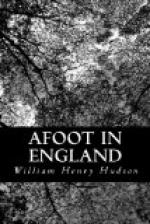All this proved very entertaining, and I was glad to laugh with the crowd, thinking that after all we were taking a very mild revenge on our hated enemies, the tyrants of the roads.
The fun over, I went soberly back to my village, and finding it impossible to get to sleep I went to Sunday-morning service at Shrewton Church. It was strangely restful there after that noisy morning crowd at Stonehenge. The church is white stone with Norman pillars and old oak beams laid over the roof painted or distempered blue—a quiet, peaceful blue. There was also a good deal of pleasing blue colour in the glass of the east window. The service was, as I almost invariably find it in a village church, beautiful and impressive. Listening to the music of prayer and praise, with some natural outdoor sound to fill up the pauses—the distant crow of a cock or the song of some bird close by—a corn-bunting or wren or hedge-sparrow—and the bright sunlight filling the interior, I felt as much refreshed as if kind nature’s sweet restorer, balmy sleep, had visited me that morning. The sermon was nothing to me; I scarcely heard it, but understood that it was about the Incarnation and the perfection of the plan of salvation and the unreasonableness of the Higher Criticism and of all who doubt because they do not understand. I remembered vaguely that on three successive Sundays in three village churches in the wilds of Wiltshire I had heard sermons preached on and against the Higher Criticism. I thought it would have been better in this case if the priest had chosen to preach on Stonehenge and had said that he devoutly wished we were sun-worshippers, like the Persians, as well as Christians; also that we were Buddhists, and worshippers of our dead ancestors like the Chinese, and that we were pagans and idolaters who bow down to sticks and stones, if all these added cults would serve to make us more reverent. And I wish he could have said that it was as irreligious to go to Stonehenge, that ancient temple which man raised to the unknown god thousands of years ago, to indulge in noise and horseplay at the hour of sunrise, as it would be to go to Salisbury Cathedral for such a purpose.
Chapter Twenty-Two: The Village and “The Stones”
My experiences at “The Stones” had left me with the idea that but for the distracting company the hours I spent there would have been very sweet and precious in spite of the cloud in the east. Why then, I asked, not go back on another morning, when I would have the whole place to myself? If a cloud did not matter much it would matter still less that it was not the day of the year when the red disc flames on the watcher’s sight directly over that outstanding stone and casts first a shadow then a ray of light on the altar. In the end I did not say good-bye to the village on that day, but settled down to listen to the tales of my landlady, or rather to another instalment of her life-story




